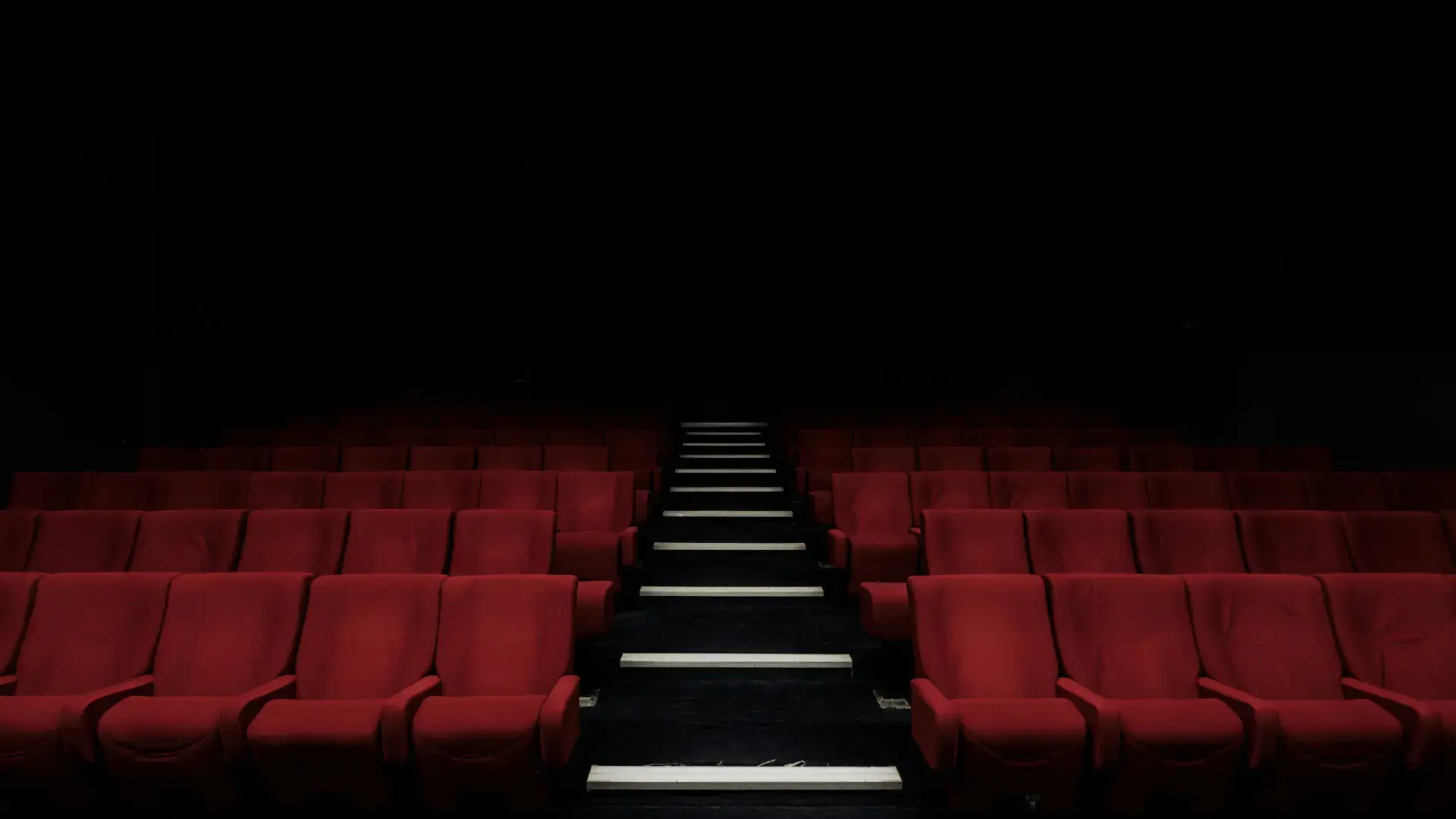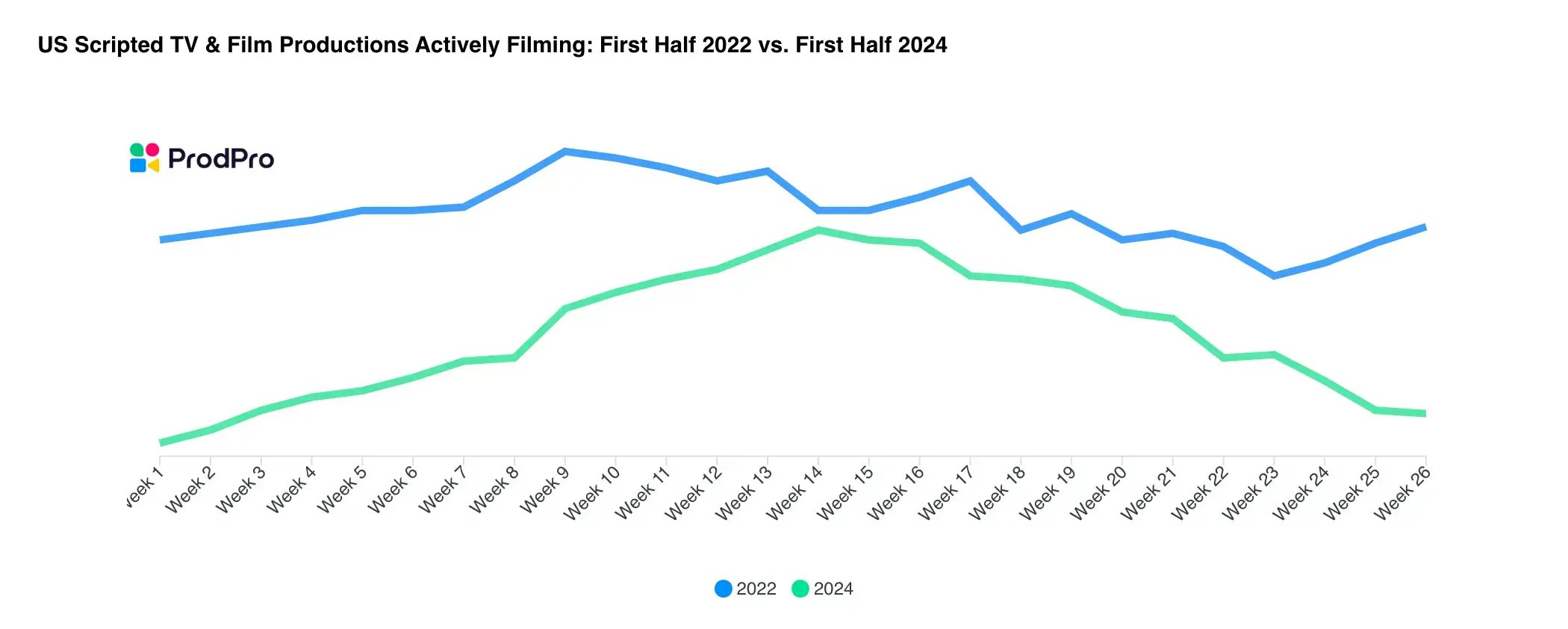
According to a new report from ProdPro, the entertainment industry continues to grapple with a significant decline in production activity. This downturn is profoundly impacting workers across the sector, from actors to crew members.
Production activity remains sluggish
ProdPro's latest report paints a sobering picture of the current state of film and TV production. While there was a 22% increase in projects actively filming in Q2 2024 compared to the same period last year, this comparison is against the backdrop of the 2023 WGA strike, which saw unusually low production activity.
The more telling statistic is that over the past six months, the total number of productions filming globally in 2024 is still 16% lower than in 2022, and a staggering 37% lower in the US. This decline is particularly challenging for an industry that has expanded to meet the demands of the peak home entertainment and streaming era.

Source: ProdPro Q2 2024 Global Production Report
However, the landscape is not uniformly bleak. Television series are experiencing a resurgence, with a 20% increase in production compared to Q2 2023. This uptick is likely driven by major studios making up for lost time and ensuring their fall slates are delivered. Conversely, feature films have taken a hit, dropping by 18%. This dichotomy underscores the shifting priorities and, perhaps, financial constraints within the industry.
 Source: ProdPro Q2 2024 Global Production Report
Source: ProdPro Q2 2024 Global Production Report
Despite the overall decline in production numbers, there are signs of hope for the industry. ProdPro reports a substantial 39% rise in committed spending from Q2 2023, driven predominantly by mid-range projects costing between $40M and $100M. This suggests that while fewer projects are getting the green light, those that do are receiving significant but sustainably mid-ranged investments.
This likely indicates a reversal in the trend of ever-ballooning budgets that drastically reduced the likelihood of profitability for projects that may otherwise have found success with more tempered production costs.
Factors contributing to the slowdown
Several factors have contributed to this prolonged production drought:
- Aftermath of the 2023 strikes: The WGA and SAG-AFTRA strikes, while resulting in important gains for writers and actors, disrupted production schedules, creating a backlog of projects and a cautious approach to new productions.
- Ongoing 2024 labor negotiations: Current International Alliance of Theatrical Stage Employees (IATSE) contract negotiations are creating uncertainty, causing some studios to hesitate in greenlighting new projects (though these look to be resolved - voting is underway this week).
- Industry-wide shift in business models: The entertainment industry is undergoing a significant change in content creation and distribution models, partly driven by evolving streaming landscapes and audience viewing habits.
- Decline in original scripted series: A 14% dip in original scripted series in 2023 signaled the potential end of the "Peak TV" era due to market saturation and the need for more sustainable production models.
- Cost-cutting measures: Studios are implementing various strategies, including early show cancellations, smaller writers' rooms, and exploring AI usage in production.
- Shift in production locations: Productions are increasingly moving to areas offering more generous tax incentives, affecting job availability in traditional production centers.
- Cautious approach to new projects: The risk of future strikes and industry changes has made it more challenging for independent film producers to secure funding, evidenced by an 18% decrease in feature film production starts.
-min.webp?width=1280&height=720&name=1280px-SAG-AFTRA_Picket_I_(53051649802)-min.webp) By Eden, Janine and Jim from New York City - SAG-AFTRA Picket
By Eden, Janine and Jim from New York City - SAG-AFTRA Picket
The human cost
Behind these statistics are real people facing significant challenges. In a memo obtained by IndieWire, The Art Directors Guild (ADG) recently reported that 75% of its 3,000 members are currently unemployed. This high unemployment rate led the ADG to suspend its Production Design Initiative program, which offers paid, on-the-job training in various art department roles.
Daniel Spenser, a graphic artist who has worked in television and film for over a decade, shared his experience with Fast Company. "I don't really know how to identify my career anymore," Spenser said. "I used to feel like I was enmeshed in a scene that had some kind of safety, but that's no longer the case. And I know a lot of people in the same boat."
The impact extends beyond just job loss. Many workers in the industry are grappling with mental health challenges due to the prolonged uncertainty. Some are considering leaving the industry altogether, while others are juggling multiple side hustles to make ends meet.
The lack of consistent work is particularly challenging for crew members like set decorators and costume designers. Amber Haley, a set decorator who has worked on shows like "Insecure" and "Modern Family," shared that she's only been able to interview for three shows in the last 15 months. "It wears on me," Haley said, speaking to the LA Times, expressing concern not just for herself but for her team members struggling to meet basic needs.
The situation is equally dire for those nearing retirement. Some workers fear years without steady work will impact their pensions, as they cannot find gigs on union-contract productions. There's also a growing concern about losing healthcare benefits due to insufficient work hours to maintain eligibility under union rules.
For younger professionals, the industry slowdown is disrupting career progression. Many who were just starting to establish themselves now find their momentum halted, forcing them to reconsider their career paths.
Despite these challenges, many in the industry remain hopeful and are finding creative ways to adapt. Some are exploring new skills or pivoting to related fields, while others are banding together to create support networks and share job opportunities. The resilience of these workers underscores the passion and dedication that has always been a hallmark of the entertainment industry.
That said, passion is only a finite resource, and we must endeavor to support those within our industry as much as possible. Charities such as the Motion Picture & Television Fund (MPTF) or the Film + TV Charity can be crucial during challenging times.
-min.webp?width=1080&height=720&name=1080px-WGA_Strike_6.21.2023_063_(52991441482)-min.webp)
By ufcw770 - WGA Strike
TL;DR Cheat Sheet:
- Production Activity: Q2 2024 saw a 22% increase in active filming projects compared to last year, but global production is still 16% below 2022 levels and 37% lower in the US.
- Worker Impact: High unemployment rates, especially among Art Directors Guild members, with 75% unemployed. Many workers face job insecurity, mental health challenges, and disruptions to career progression.
- Financial Commitment: Despite fewer projects, committed spending rose by 39% from Q2 2023, especially for mid-range projects ($40M-$100M), indicating substantial investment in fewer but larger projects.
Tags: Post & VFX Production Business


Comments